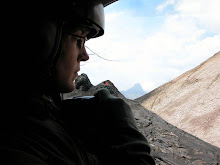 It began last May:
It began last May:When rain began to threaten and winter seemed close, many of the people began to cut and clear their land ¨limpiarla.¨ When the brush and shrubs were cleared away, they waited for the fallen plants and the bare soil to dry. This year, they had to wait much longer than normal - many of my neighbors complained that this was a very wet summer in southern Comarca Ngäbe-Bugle. By late may/early June, plumes of gray could be seen from the hillsides, little by little, the people were able to burn the fields - a final step to prepare the soil.
Ovidia and her family have plans to plant both rice and corn this winter. What kind? I was told there is a ¨fast rice¨ that will only need 3-4 months of growth before it´s harvested.
I arrived in the morning after being invited to photograph their family. It was a bright hot day, but the sky was already filling with clouds.
¨Where will we work?¨
¨This hillside, this is where we will plant rice. On the other side, the children are already planting corn. Put 6-8 grains in each hole and cover well with soil. My brother is already placing the holes (roughly 1 foot apart).¨
 So we worked for hours this way, that is, until I decided to photograph my neighboring planters...
So we worked for hours this way, that is, until I decided to photograph my neighboring planters...Olvidia´s sister, Guillermina worked the right-hand side and asked several questions about what is grown in The States. I tried to explain how family-owned farms still exist but the largescale planting is done by companies. That was when I suddenly remembered that I hadn´t mentioned the Thanksgiving tale to them yet! So, with very rough story-telling skills, I tried to explain how badly the Pilgrims failed when trying to establish crops in New England´s rocky soil:
¨Y el suelo tiene bastante rocas y piedras, no fue posible sembrar muchas cosas. Fue un tiempo malo, un tiempo de hambre. Pero habian grupos de indígenas también ...¨
¨¿Indígenas... como nosotros? ¿Cómo le parece? ¿Cómo está su lenguage?¨
¨Pues, se llama Wampanoag y ellos fueron muy similar a ustedes.¨
¨¿Y su lenguage? ¿Cómo habla en su lenguage?¨

¨Bueno, no estoy muy familiar con el lenguage, pero algunas palabras son como: Annisquam, Wawinet, Quidnet, Nantucket, ... estas son palabras del otro lenguage.¨
¨¿Y que significa tienen las palabras?¨
¨Pues, en realidad, no sé. Algunos discriben lugares.¨
¨Ah, sí.¨
¨Sí, eso es.¨
Her interest in ¨otras indígenas¨ isn´t the first time I´ve encountered questions about different cultures within The States. My other neighbors also ask: do they speak English, do they have land, do they have our skin color (one guy asks if they are ¨red like us¨), do they have hair like us?
And so I continue the story and finish with a punchline:

¨Y la idea nueva fue una estrategía. Pusieron una sardina conjuntos las semillas de maiz.¨
(And the new idea was a strategy. They put sardines in the ground with every corn seed.¨)
I love Thanksgiving and it was wonderful to explain the roots of such a large celebration, of why we celebrate and how: platefuls of food!
I know that the ¨indigenous¨ words I used were just town names in my home state. I know that they likely have a lost meaning, maybe a discription of the region, maybe the name of the particular people that used to live there. But just to sound out the different words, just to give an example of what the language might have been like... I thought that was useful for my Ngäbe friends. The complicated and not-so-idyllic relationship between my ancestors ¨antepasados¨and the original people of New England would be hard to explain. I went as far as saying that we have made ¨convenios¨ with the indigenous people and at least today, there is peace between us.
At just about noon, rain began to fall and suddenly the view to Cerro Iglesias was just a blank sheet, an aguacero was on its way - time for lunch!




No comments:
Post a Comment